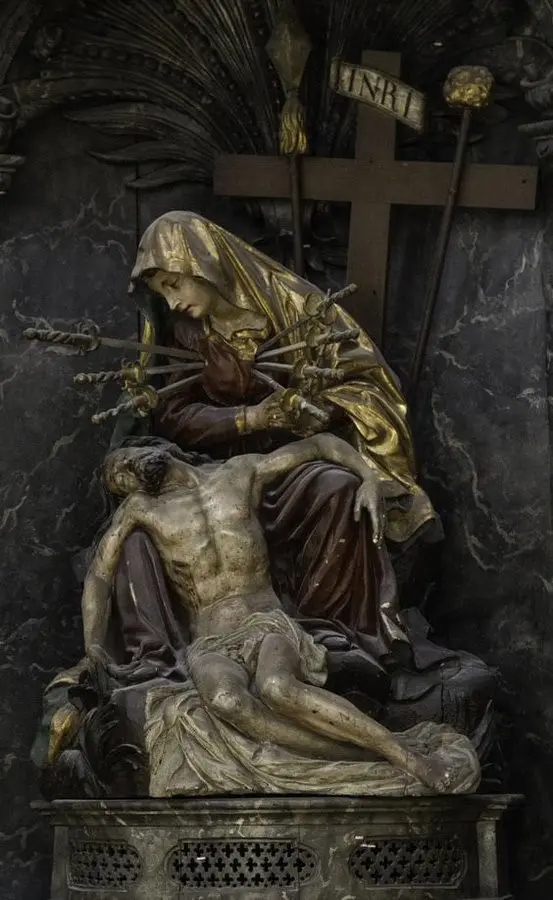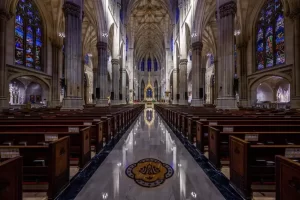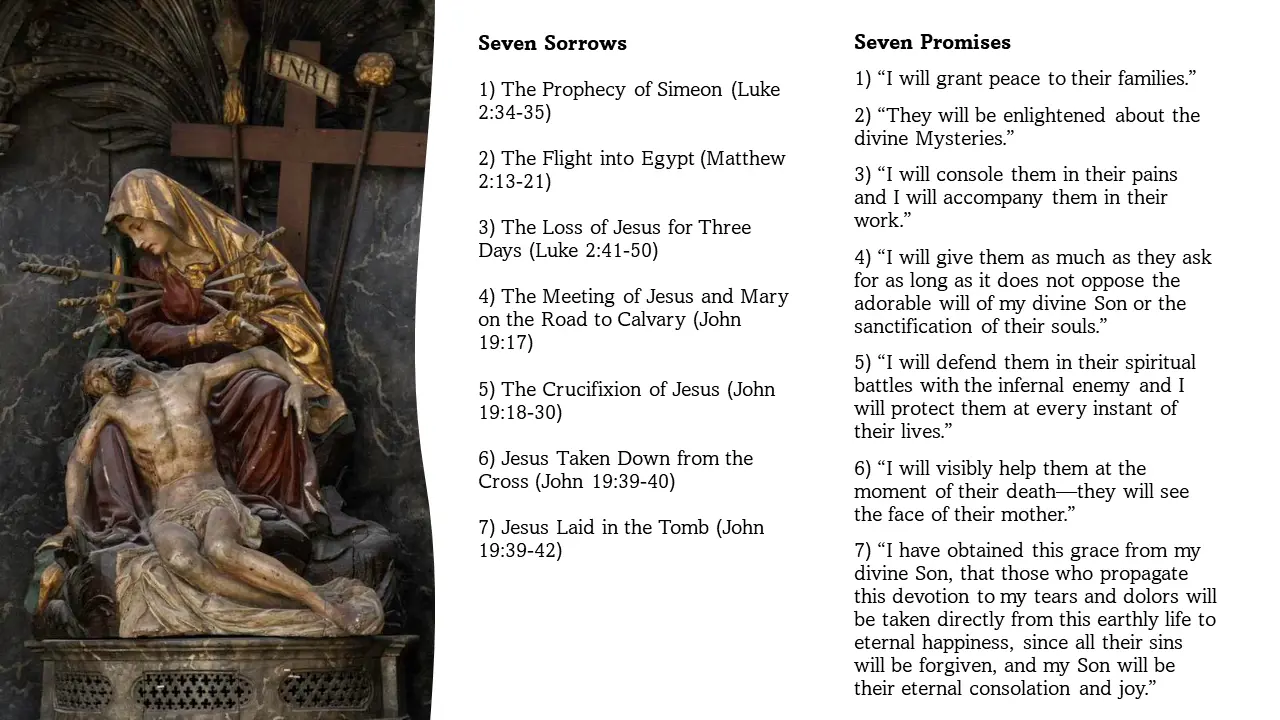
Vicki Yamasaki, Founder, Corpus Christi for Unity and Peace, CUP@corpuschristiforunityandpeace.org
Throughout my years of frequent business travel—from the 1990s until my retirement—I always held one priority close to my heart: attending Mass. No matter the city or the importance of the business meeting, Mass remained my anchor.
On a particular trip to New York, where I was meeting with Standard & Poor’s, I found myself near St. Patrick’s Basilica. It was there, on the feast of Our Lady of Sorrows (September 15), that something extraordinary happened.
At that time, my faith reversion was taking root and growing. I knew little about devotion to Our Lady of Sorrows. Yet, as I sat in the pew, I discovered a prayer card left behind—a simple invitation to meditate on our Blessed Mother’s Seven Sorrows, a devotion passed down by St. Bridget.
That moment changed me. It struck me deeply—the idea of consoling the Sorrowful Mother of our Lord and honoring her. So profoundly moved, I promptly ordered 500 of those prayer cards and began sharing the devotion with others. After all, what mother, or anyone for that matter, wouldn’t want to offer solace to the one who stood by her suffering Son?
And so, in the quiet of that basilica, Our Lady of Sorrows touched my heart, and I became an unwitting messenger of her grace.

St Patrick’s Basilica
Origins and Development of Devotion to Our Lady of Sorrows
Devotion to Our Lady of Sorrows has a rich history that can be traced back to St. John, who stood with Mary at the foot of the Cross during Christ’s Crucifixion. However, it was in the early 13th century that this devotion truly blossomed. The Servite Order, founded in 1233, played a pivotal role in promoting it. These seven founders of the Servite Order, five years after establishing themselves on Monte Senario, embraced Mary’s sorrows as the central focus of their order. Mary appeared to them, expressing her desire for them to form an Order dedicated to practicing and spreading devotion to her Sorrows.
The Feast of Our Lady of Sorrows
Interestingly, the corresponding feast did not originate directly from the Servite Order. Instead, it was established by a provincial synod in Cologne in 1413. The purpose of this feast, known as the “Commemoratio angustix et doloris B. Marix V.” (Commemoration of the sorrows and pains of the Blessed Virgin Mary), was to expiate the crimes of the iconoclast Hussites. It was to be observed on the Friday after the third Sunday after Easter, focusing exclusively on Mary’s sorrow during Christ’s Crucifixion and Death.
Spread and Formalization
Before the 16th century, this feast was primarily celebrated in the dioceses of North Germany, Scandinavia, and Scotland. However, after 1600, it gained popularity in France and was referred to as “Dominx N. de Pietate,” observed on the Friday before Palm Sunday. Later, in 1674, the entire German Empire adopted this date for the feast.
By a decree issued in 1727, Pope Benedict XIII extended the devotion to the entire Church. The feast became known as the “Septem dolorum B.M.V.” (Seven Sorrows of the Blessed Virgin Mary). Despite this expansion, the Office and Mass retained the original focus: Mary’s compassion at the foot of the Cross.
Feast Day and Seven Sorrows
Today, we celebrate the Feast of the Seven Sorrows of the Blessed Virgin Mary on September 15. On this day we reflect on each of the Seven Sorrows (as illustrated below). This day commemorates Mary’s deep compassion and suffering. It falls just one day after the Feast of the Exaltation of the Holy Cross (September 14).
Why Devote Ourselves to Our Lady of Sorrows
In Revelations of St. Bridget, “Our Lady lamented to St. Bridget that very few consoled Her by meditating on Her Sorrows, and that the greater part of the world lived in forgetfulness of them:
‘I look around at all who are on earth, to see if by chance there are any who pity Me, and meditate upon My Sorrows; and I find that there are very few. Therefore, My daughter, though I am forgotten by many, at least do you not forget Me; consider My anguish, and imitate, as far as you can, My grief.’”
St. Bridget of Sweden received many revelations from Our Lady concerning her sorrows and promoted this devotion widely.
Along with St. Bridget, St. Alphonsus Ligouri had written extensively about the sorrows of Mary and encouraged the faithful to meditate on them. In his book, the Glories of Mary he wrote:
“Wherefore the graces promised by Jesus to those who are devoted to the dolors of Mary are very great.”
“Now, as the soul is more noble than the body, so much greater were Mary’s sufferings than those of all the martyrs, as Jesus Christ Himself said to St. Catherine of Siena: ‘Between the sufferings of the soul and those of the body there is no comparison.’”
In 1724, Pope Benedict XIII promulgated and encouraged the practice of the devotion to Our Lady’s Sorrows by bestowing many indulgences for the recitation of the Chaplet of the Seven Sorrows. The Chaplet of Seven Sorrows was reaffirmed by Pope Clement XII and Pope Clement XIII.
Pope Pius VII had a devotion to Our Lady of Sorrows and approved a series of prayers in honor of the Seven Sorrows for daily meditation in 1815. Click here to access the audio version to pray. He further said:
Promises Made
Our Lady revealed to St. Bridget of Sweden seven promises regarding those who pray the Seven Sorrows Chaplet or meditate on her seven dolors:

Protections Against Diabolic Incursion
Fr. Chad Ripperger has spoken about the protective power of devotion to Our Lady of Sorrows. In his talks and writings, he emphasizes that those who have a devotion to her will receive her protection, especially from diabolical incursions. One of his notable discussions on this topic can be found in his talk titled “Our Lady of Sorrows and Healing,” where he explains how demons fear Our Lady and how she offers protection to those devoted to her.
Our Lady of Sorrows, truly a mother of consolations, extends her comforting presence to those in sorrow. She not only consoles us individually but also aids in revealing hidden defects with us and hidden aspects—even those within our own families.
Allow me to share an extraordinary example: In January, during our book study of the Liber Christo Method, I offered a humble prayer to Our Lady of Sorrows. My request was simple: “Our Lady of Sorrows, please reveal to me any Freemasonic connection in my family.” Remarkably, despite our family disposing of all possessions in my bloodline, a locked chest of my great grandfather’s—untouched for at least half a century—resurfaced unexpectedly. Our daughter, driven by curiosity, pried it open from the back hinges (since there was no key). And there, concealed within, lay Freemasonic link.
Truly, Our Lady of Sorrows has a way of bringing hidden truths to light, even when we least
Join Us in Honoring Our Lady of Sorrows: A Novena from September 7 to September 15
As we approach this significant feast day, let’s come together to console Our Lady’s heart by praying a Novena to Our Lady of Sorrows. From September 7 to September 15, we’ll meditate on the Seven Sorrows of the Blessed Virgin Mary and honor our Blessed Mother.
Feel free to use the link here to join us, starting on Saturday, September 7. You can download the Novena Prayer by clicking on this link: _Novena_OLofSorrows
